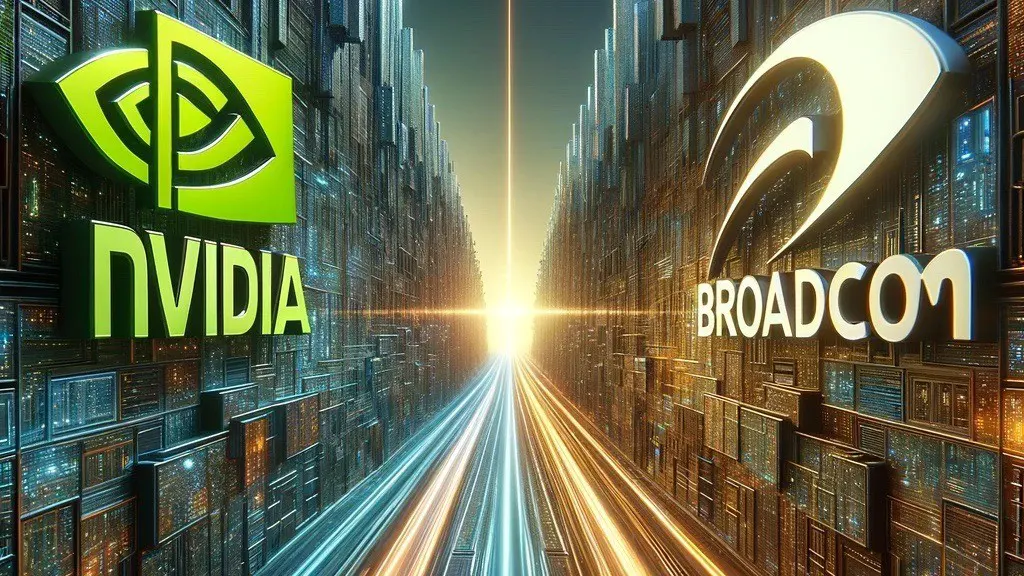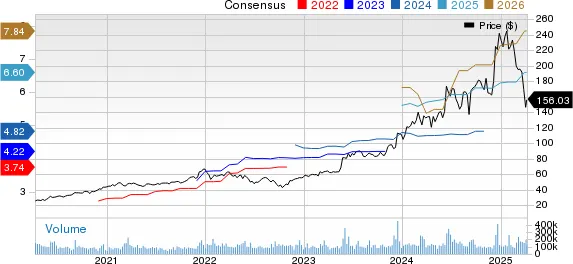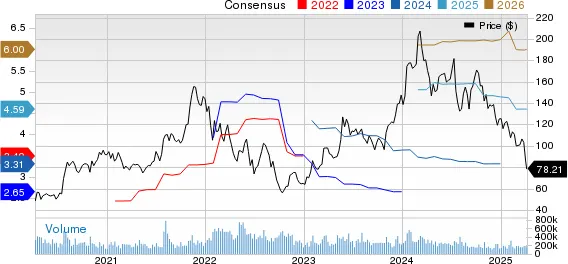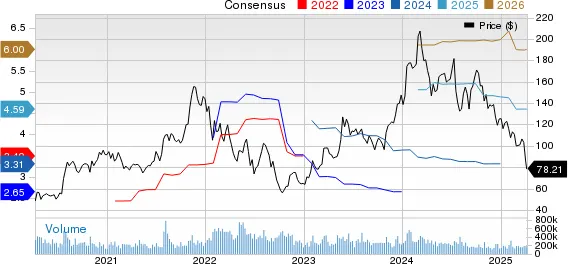
The semiconductor industry is a cornerstone of the modern digital economy, powering everything from smartphones and laptops to data centers and self-driving cars. Among the industry's titans, two names stand out as fierce competitors and significant players: Advanced Micro Devices (AMD) and Broadcom Inc. (AVGO). As we look ahead in a market marked by rapid innovation and fluctuating demand, investors are increasingly asking: which of these chip giants presents the better investment opportunity?
In this deep-dive analysis, we explore the business models, financial performance, technological innovations, market positioning, and future outlooks of AMD and Broadcom. Whether you're a seasoned investor or a tech enthusiast considering semiconductor stocks, this comprehensive guide will help you make an informed decision.
AMD vs. Broadcom Company Overviews:
AMD
Founded in 1969 and headquartered in Santa Clara, California, AMD designs and develops high-performance computing and graphics solutions. Over the past decade, AMD has undergone a remarkable transformation under the leadership of CEO Dr. Lisa Su. The company has successfully gained market share in both consumer and enterprise segments, largely thanks to its Ryzen CPUs, EPYC server processors, and Radeon GPUs.
AMD's major product lines include:
• Ryzen CPUs for desktop and laptop PCs
• EPYC CPUs for data centers and cloud computing
• Radeon GPUs for gaming and professional graphics
• Semi-custom chips for gaming consoles (e.g., Sony PlayStation and Microsoft Xbox)
Broadcom Inc. (AVGO)
Broadcom, originally founded as a division of Hewlett-Packard and later spun off and merged through various acquisitions, has evolved into one of the most diversified semiconductor companies in the world. Headquartered in San Jose, California, Broadcom specializes in a wide range of products including networking chips, storage adapters, broadband devices, and wireless components.
Broadcom’s business model includes two main segments:
• Semiconductor Solutions: Network and wireless connectivity chips, storage, broadband, and custom ASICs.
• Infrastructure Software: Enterprise software solutions including Symantec, CA Technologies, and VMware.
Financial Performance Comparison
Let’s take a look at the financials of AMD and Broadcom. The numbers below are approximations based on the most recent fiscal reports. The Zacks Consensus Estimate for AVGO’s fiscal 2025 earnings is pegged at $6.60 per share, up 4 cents over the past 30 days, indicating a 35.52% increase over fiscal 2024’s reported figure.
1. Broadcom Inc. Stock Price and Consensus

However, the consensus mark for AMD’s 2025 earnings has been steady at $4.59 per share over the past 30 days, suggesting 38.67% growth over 2024.
2. Advanced Micro Devices, Inc. Stock Price and Consensus

Both AVGO’s and AMD’s earnings beat the Zacks Consensus Estimate in all the trailing four quarters. However, Broadcom’s average surprise of 3.44% is better than AMD’s surprise of 2.32%, reflecting good quality of earnings beat on a consistent basis.
| Metric | AMD | Broadcom (AVGO) |
|---|---|---|
| Market Cap | ~$250B | ~$580B |
| Revenue (TTM) | ~$23B | ~$35B |
| Gross Margin | ~50% | ~74% |
| Net Income | ~$3B | ~$12B |
| EPS (TTM) | ~$2.92 | ~$28.32 |
| P/E Ratio | ~90x | ~26x |
| Dividend Yield | 0% | ~2.2% |
| Debt-to-Equity Ratio | ~0.05 | ~1.6 |
Key Takeaways:
• Broadcom is significantly larger in terms of revenue, net income, and market cap.
• AMD has been focused on growth and innovation, reinvesting heavily rather than paying dividends.
• Broadcom’s higher margins and dividends make it attractive for income-focused investors.
Technological Leadership
AMD’s Edge
AMD is widely recognized for its innovative chip designs based on advanced 5nm and 7nm fabrication processes. Its Ryzen and EPYC processors have been successful in disrupting Intel’s long-held dominance in the CPU space. AMD is also a strong player in gaming and AI workloads.
• Performance vs. Intel: AMD chips often outperform Intel’s in multi-core benchmarks and offer better performance-per-dollar.
• AI & HPC: AMD’s MI300 accelerators are geared toward AI and high-performance computing workloads.
Broadcom’s Advantage
Broadcom is not typically in the spotlight for consumer-facing innovation but is a behemoth in enterprise infrastructure. Its chips are found in nearly every smartphone and data center, and it holds leading positions in network switching, broadband, and Wi-Fi chips.
• Enterprise Dominance: Broadcom powers networking for major data centers and telecommunications providers.
• Custom Silicon: Offers custom chips for cloud providers and hyperscalers.
• Software Integration: The company’s expansion into enterprise software gives it a hybrid edge.
Market Positioning
AMD
AMD has firmly positioned itself as a leading player in the high-performance computing and AI markets. With its expanding portfolio of EPYC processors, Instinct accelerators, and the ROCm software ecosystem, AMD is a major force in powering cloud data centers, AI workloads, and hyperscale environments.
In 2024, AMD delivered over $5 billion in AI-related data center revenue, driven by strong MI300X adoption by tech giants like Meta and Microsoft. Its EPYC server processors saw 27% growth, with over 1,000 instances launched across major cloud providers including AWS, Google Cloud, and Tencent. Looking ahead, AMD is aggressively investing in next-gen AI with its MI325X in production, MI350 (CDNA 4) promising 35x performance gains, and MI400 slated for a 2026 release. Strategic acquisitions—including ZT Systems, Silo AI, Nod.ai, and Mipsology—further enhance its AI capabilities and ecosystem depth.
With a competitive edge in power efficiency, scalability, and integration, AMD is well-positioned to challenge incumbents and capture greater share in the cloud, AI, and data center segments.
• Strengths: High-performance CPUs/GPUs, strong presence in gaming and cloud computing, rapidly gaining server market share.
• Weaknesses: Lower margins, intense competition, limited diversification.
Broadcom
Broadcom (AVGO) has established itself as a dominant force in the custom silicon and networking infrastructure space, with a strong focus on AI acceleration, hyperscale data centers, and next-gen connectivity. Its leadership in application-specific integrated circuits (ASICs) and custom AI accelerators (XPUs) positions it at the core of the AI infrastructure buildout.
Broadcom's cutting-edge 3nm XPUs, the first of their kind, are set for high-volume deployment with hyperscale customers in the second half of fiscal 2025. The company is also pioneering 2nm AI XPU designs with advanced 3.5D packaging, targeting massive scalability—clusters of up to 500,000 accelerators per deployment.
Looking ahead to 2027, Broadcom anticipates each of its top three hyperscaler partners will deploy 1 million XPUs across unified fabrics. The company projects a combined addressable market for XPUs and networking between $60 billion and $90 billion by fiscal 2027.
Broadcom’s strong ecosystem of partners—including NVIDIA, Dell, Arista Networks, Juniper, and Supermicro—enhances its value proposition across AI, cloud, and enterprise markets. With projected AI revenue growth of 44% YoY in Q2 FY2025 and overall semiconductor revenue expected to reach $14.9 billion, Broadcom is well-positioned as a foundational enabler of next-gen AI infrastructure.
• Strengths: Diversified revenue streams, high margins, enterprise focus, strong IP portfolio.
• Weaknesses: Heavy reliance on key customers like Apple, significant debt from acquisitions.
Investment Outlook
AMD’s Growth Story
AMD is still very much a growth company. With strong tailwinds in AI, gaming, and data centers, AMD is poised for further expansion. The upcoming rollout of AI chips and the potential to capture more server market share are key growth catalysts. However, investors must consider:
• Volatility: The stock tends to be more volatile and sensitive to tech market swings.
• Valuation: High P/E ratios suggest premium expectations.
Broadcom’s Stability and Income
Broadcom offers a more stable investment profile with predictable cash flows, robust dividend payouts, and steady growth through acquisitions. The upcoming VMware acquisition could significantly expand Broadcom's footprint in the software domain. However:
• Debt: Frequent acquisitions add to the company’s debt load.
• Integration Risk: Managing large software mergers comes with operational challenges.
Overall Comparison: AMD vs Broadcom
Advanced Micro Devices AMD and Broadcom AVGO are key providers of semiconductor chips that power artificial intelligence (AI). Chips from these companies support running of Large Language Models that form the backbone of Generative AI (Gen AI). Growing AI deployment bodes well for both AMD and AVGO. The Semiconductor Industry Association (SIA) expects double-digit growth rate in 2025 with semiconductor sales surging 19.1% to $627.6 billion in 2024.
However, both AMD and Broadcom shares have suffered from tech sell-off year to date (YTD) amid rising fears of a recession following U.S. President Donald Trump’s decision to levy tariffs on top trading partners, including China, Mexico and Canada, which has increased the chances of a trade war. Semiconductor companies, including Broadcom and AMD, import key parts to international markets, which makes them vulnerable to a trade war.
| Feature | AMD | Broadcom (AVGO) |
| Revenue Base | Smaller, fast-growing | Larger, stable |
| Innovation Focus | CPUs/GPUs, HPC, AI | Networking, storage, software |
| Risk Level | Higher (growth stock) | Lower (dividend/income stock) |
| Dividend | None | 2%+ annually |
| Market Exposure | Consumer, enterprise, gaming | Enterprise, telco, hyperscalers |
| Valuation | Expensive (high P/E) | Moderate (reasonable P/E) |
| Software Portfolio | Minimal | Expanding significantly |
| M&A Strategy | Conservative | Aggressive |
| Debt Load | Low | High |
• AMD
AMD is rapidly gaining momentum in the cloud data center and AI chip markets with its 5th-gen EPYC Turin, 4th/3rd-gen EPYC processors, Instinct accelerators, and ROCm software suite. In 2024, AMD generated over $5 billion in data center AI revenue, driven by strong MI300X deployments from Meta and Microsoft. EPYC instances grew 27% year-over-year to over 1,000, with hyperscalers like AWS, Alibaba, Google, Microsoft, and Tencent launching 100+ AI instances in Q4 alone.
Instinct accelerators saw robust demand from a dozen cloud providers, including IBM and Digital Ocean, with more expected in 2025. The MI325X is now in production, while the upcoming MI350 series, based on CDNA 4, will boost AI performance by 35x over CDNA 3 and begin shipping mid-year. MI400 development is also on track for a 2026 launch. To strengthen its AI ecosystem, AMD has acquired companies like ZT Systems, Finland-based Silo AI, Nod.ai, and Mipsology.
• Broadcom
Broadcom is seeing strong demand for its AI-focused ASICs and custom accelerators (XPUs), which efficiently integrate compute, memory, and I/O for training generative AI models. Its next-gen 3nm XPUs are the first in their class and are set for volume shipments to hyperscalers in the second half of fiscal 2025. Broadcom is also developing the industry’s first 2nm AI XPU with 3.5D packaging, aiming to scale to 500,000-accelerator clusters.
By 2027, Broadcom expects each of its three major hyperscaler customers to deploy 1 million XPUs across unified fabrics. The addressable market for XPUs and networking could reach $60–90 billion in fiscal 2027. Key partners like NVIDIA, Arista, Dell, Juniper, and Supermicro support its growth. In Q2 fiscal 2025, Broadcom forecasts AI revenue to rise 44% YoY to $4.4 billion, with semiconductor revenue expected to grow 17% to $14.9 billion.
Final Verdict

Valuation-wise, both AMD and Broadcom are overvalued, as suggested by the Value Score of D. However, in terms of forward 12-month Price/Sales, AMD shares are trading at 3.77X, lower than AVGO’s 10.99X. Broadcom’s expanding AI portfolio, along with a rich partner base, reflects solid top-line growth potential. AMD’s near-term prospects are dull, given the weakness in the Gaming and Embedded segment and stiff competition from NVIDIA in the Data Center space. Choosing between AMD and Broadcom depends largely on your investment goals:
• If you’re looking for growth potential and can stomach higher volatility, AMD is the better bet.
• If you prefer stable returns, dividends, and less volatility, Broadcom is more suitable.
Both companies are leaders in their domains, and a diversified portfolio could even include both stocks to balance growth with income. As with any investment, thorough due diligence, risk tolerance evaluation, and market trend analysis are key. Whether you back the AI-charged rise of AMD or the enterprise resilience of Broadcom, both companies are positioned to shape the future of the semiconductor landscape.
Frequently Asked Questions (FAQ)
Q1: Which company has better long-term growth potential?
• AMD shows higher growth potential due to its aggressive R&D in AI and data center markets. However, Broadcom’s acquisitions in software may diversify and fuel long-term growth in a different way.
Q2: Which stock is better for dividend investors?
• Broadcom, hands down. It offers a consistent and growing dividend yield, which is attractive for income-focused portfolios.
Q3: Is AMD too expensive right now?
• AMD’s valuation is high compared to its earnings, so it may be priced for perfection. However, investors with a long-term view might see upside if AMD continues gaining market share.
Q4: What are the major risks for each company?
• AMD: Market competition, reliance on TSMC for chip production, tech sell-offs.
• Broadcom: Customer concentration, debt from acquisitions, regulatory scrutiny.
Q5: Which company is more affected by geopolitical tensions?
• Both companies operate globally and are affected by trade restrictions, especially U.S.-China relations. Broadcom, however, has more exposure to Apple and telecom markets which could face export risks.
Q6: How do they compare in AI readiness?
• AMD is more directly involved in AI chip development. Broadcom contributes to AI infrastructure (e.g., networking) but is not a front-runner in AI compute chips.
Extended Reading
• Broadcom Chips(ICs): A Deep Dive into One of the Leading Semiconductor Giants
• Sourcing Broadcom IC Parts: Authorized Distributors or Independent Distributors?
• Broadcom's AI Chip Boom: Record-Breaking Earnings Propel Stock Surge
• Broadcom News: Latest Developments, AI Growth, Product Innovations, and Distribution Insights
Written by Jack Zhang from AIChipLink.
AIChipLink, one of the fastest-growing global independent electronic component distributors in the world, offers millions of products from thousands of manufacturers, and many of our in-stock parts is available to ship same day.
We mainly source and distribute integrated circuit (IC) products of brands such as Broadcom, Microchip, Texas Instruments, Infineon, NXP, Analog Devices, Qualcomm, Intel, etc., which are widely used in communication & network, telecom, industrial control, new energy and automotive electronics.
Empowered by AI, Linked to the Future. Get started on AIChipLink.com and submit your RFQ online today!







.png&w=256&q=75)





